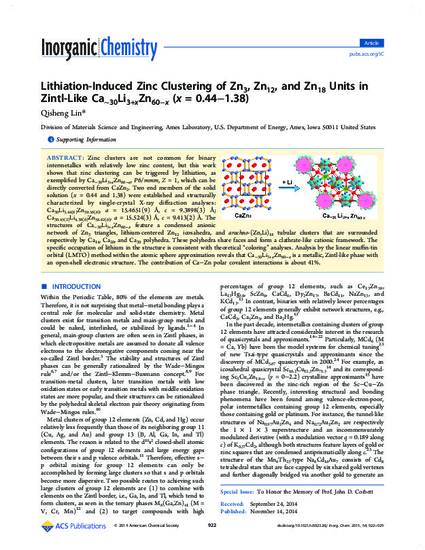
Zinc clusters are not common for binary intermetallics with relatively low zinc content, but this work shows that zinc clustering can be triggered by lithiation, as exemplified by Ca∼30Li3+xZn60–x, P6/mmm, Z = 1, which can be directly converted from CaZn2. Two end members of the solid solution (x = 0.44 and 1.38) were established and structurally characterized by single-crystal X-ray diffraction analyses: Ca30Li3.44(6)Zn59.56(6), a = 15.4651(9) Å, c = 9.3898(3) Å; Ca30.45(2)Li4.38(6)Zn58.62(6), a = 15.524(3) Å, c = 9.413(2) Å. The structures of Ca∼30Li3+xZn60–xfeature a condensed anionic network of Zn3 triangles, lithium-centered Zn12 icosahedra, and arachno-(Zn,Li)18 tubular clusters that are surrounded respectively by Ca14, Ca20, and Ca30polyhedra. These polyhedra share faces and form a clathrate-like cationic framework. The specific occupation of lithium in the structure is consistent with theoretical “coloring” analyses. Analysis by the linear muffin-tin orbital (LMTO) method within the atomic sphere approximation reveals that Ca∼30Li3+xZn60–x is a metallic, Zintl-like phase with an open-shell electronic structure. The contribution of Ca–Zn polar covalent interactions is about 41%.
Available at: http://works.bepress.com/qisheng-lin/25/

This is an article from Inorganic Chemistry 54 (2015): 922, doi: 10.1021/ic502326j. Posted with permission.